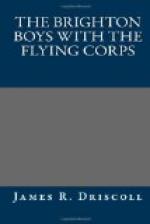He had many questions to ask the boys about the home folks, and said that he had been trying to get a chance to visit Harry for weeks. Will was particularly interested to hear what had been the experiences of the Brighton fliers in connection with their first real work at the front.
Four of the boys had been over the German lines by that time. Like Jimmy Hill, Joe Little had been out on a hunter machine. His experiences were uneventful, however. His job had been to watch, with another hunter, while a speedy, big bomber dropped hundreds of pounds of explosives on an enemy munition dump.
The whole affair went through like a dress rehearsal, and without a hitch. They flew straight for their objective, found it without the slightest difficulty, deposited a load of high explosives upon it in quick time, and soared away back home without a single encounter with an enemy plane. They were, it was true, severely “Archied,” as they called it, but no one of them was the worse for it.
Harry Corwin had been over the Boche lines three times, and had found the experience quite sufficiently exciting, though he had not been in actual combat at close quarters with the enemy as had Jimmy Hill.
His work for three mornings had been to escort a certain observation plane which had been sent each day to watch the development of a reserve line of dugouts well in the rear of the German front line. As a matter of fact, the pilot of the observation machine, a swift triplane, was well known as a dead shot. He needed an escort machine less than Harry did, Harry thought.
That triplane was about as formidable in appearance as any aircraft could be. It was only a two-seater, but it was armed with two machine-guns, singularly well placed. The front rapid-firer was fixed between the two supporting planes, the barrel next to the motor and parallel with it. This front gun was fired by Richardson, the pilot of the triplane, who controlled it with his right hand. This was a radical departure from some of the more usual gun positions, in which the gun was customarily located on the upper plane and operated by the observer.
Having a gun all to himself had pleased Richardson mightily, and he had become a wonderful shot.
The second gun on the triplane was placed on the framework behind the observer’s station. It was mounted on a revolving base, and had an exceptionally wide range of fire.
“It is a pure joy, sometimes,” Richardson was once heard to say, “to see the way the little major grins when some chesty Boche has thought he had us sure, and comes creeping up behind, only to get a dose right in the nose. That gun of the major’s carries further than anything we have run against yet, and he just couldn’t miss a Hun to save his life.” The major was Richardson’s observer.
Another yarn that Richardson was accustomed to tell on his companion of the upper reaches ran as follows: “When they first put me at carting observation planes around I was pretty green. I had but very shortly before done my first solo in England. The British were fairly short of fliers then, or I should not have been sent out. I arrived at the airdrome full of conceit, thinking I was a real pilot.




